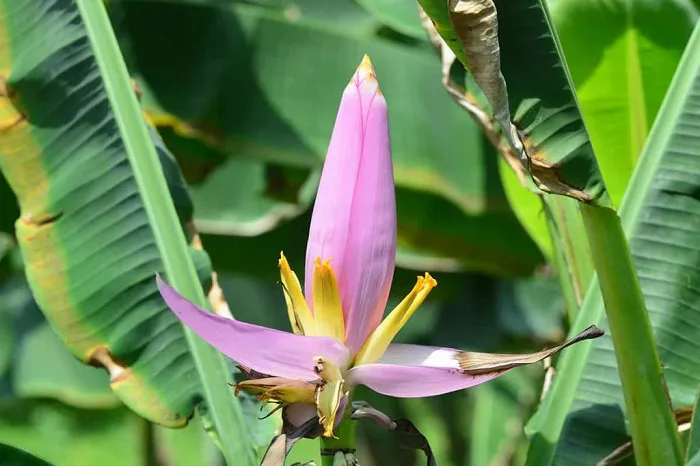Banana flowers, often overlooked in favor of the fruit they precede, are fascinating and intricate structures that deserve a closer look. These flowers are not only visually captivating but also play a crucial role in the life cycle of the banana plant. From their unique appearance to their cultural significance, banana flowers offer a window into the wonders of nature. In this article, we will explore the various aspects of banana flowers, from their physical characteristics to their uses and symbolism.
The Appearance of Banana Flowers
Banana flowers are a sight to behold, with their distinct shape and color. They emerge from the end of the flower stalk, known as the inflorescence, which can be quite long and drooping. The flower itself is composed of several layers, each with its own unique features.
Structure and Composition
The outermost layer of the banana flower is a series of bracts, which are modified leaves that protect the inner flowers. These bracts are typically large and waxy, with a deep purple hue that contrasts beautifully with the green of the plant. As you peel back each bract, you reveal rows of small, white flowers nestled within. These flowers are the reproductive structures of the plant, with both male and female flowers present on the same inflorescence.
Color and Texture
The color of banana flowers is one of their most striking features. The bracts range from a rich, dark purple to a lighter, more reddish hue, depending on the variety of banana plant. The flowers themselves are usually white or cream-colored, adding a delicate contrast to the vibrant bracts. The texture of the bracts is thick and waxy, providing a protective barrier for the delicate flowers inside. The flowers, on the other hand, are soft and smooth, with a slightly sticky texture due to the presence of nectar.
The Lifecycle of Banana Flowers
Understanding the lifecycle of banana flowers provides insight into their role in the banana plant’s reproductive process. From the initial emergence of the inflorescence to the development of fruit, each stage is crucial for the plant’s survival.
Emergence and Development
The banana flower begins its journey as a bud at the end of the flower stalk. Over time, this bud grows and elongates, eventually forming the inflorescence. As the bracts unfold, the flowers are exposed to the elements, allowing for pollination to occur. The process is gradual, with each bract opening in sequence to reveal the flowers beneath.
Pollination and Fruit Development
Banana flowers are primarily pollinated by bats and insects, which are attracted to the nectar produced by the flowers. Once pollination occurs, the flowers begin to develop into fruit. The female flowers, located at the base of the inflorescence, are the ones that produce the bananas we are familiar with. The male flowers, found at the tip, do not develop into fruit but play a role in attracting pollinators.
Cultural and Culinary Uses of Banana Flowers
Beyond their role in the banana plant’s lifecycle, banana flowers have significant cultural and culinary uses. In many parts of the world, they are considered a delicacy and are used in a variety of dishes.
Culinary Uses
Banana flowers are edible and are often used in traditional cuisines. They can be prepared in various ways, including boiling, frying, or even used in salads. The flowers have a mild, slightly bitter taste that adds a unique flavor to dishes. In some regions, they are stuffed with spices and cooked, making for a delicious and nutritious meal.
Cultural Significance
In many cultures, banana flowers hold symbolic meanings. They are often used in religious ceremonies and traditional rituals. In some parts of Asia, banana flowers are considered a symbol of prosperity and good fortune, making them a popular choice for festive occasions.
Growing and Caring for Banana Plants
For those interested in growing banana plants, understanding the care and maintenance required is essential. Banana plants thrive in warm, humid climates and require specific conditions to flourish.
Soil and Sunlight
Banana plants prefer well-draining soil that is rich in organic matter. They also require plenty of sunlight, ideally six to eight hours per day. Ensuring that the soil remains moist but not waterlogged is crucial for the plant’s health.
Watering and Fertilization
Regular watering is necessary to keep the soil consistently moist. However, overwatering can lead to root rot, so it is important to monitor the soil’s moisture levels. Fertilizing the plant with a balanced fertilizer every few months can help support its growth and development.
Common Issues and Solutions
Growing banana plants can come with its own set of challenges. Understanding common issues and how to address them can help ensure a healthy and productive plant.
Pests and Diseases
Banana plants are susceptible to various pests and diseases, including aphids, spider mites, and fungal infections. Regularly inspecting the plant for signs of infestation and treating any issues promptly can help prevent damage. Using organic pest control methods, such as neem oil, can be effective in managing pests.
Environmental Factors
Environmental factors, such as temperature fluctuations and strong winds, can also impact the health of banana plants. Providing protection from extreme weather conditions and ensuring that the plant is planted in a sheltered location can help mitigate these issues.
Conclusion
Banana flowers are a remarkable part of the banana plant, offering both beauty and functionality. Their unique appearance and lifecycle make them a fascinating subject for gardeners and nature enthusiasts alike. Whether enjoyed for their aesthetic appeal or their culinary and cultural uses, banana flowers are a testament to the wonders of the natural world.
By understanding their characteristics and care requirements, we can appreciate these delicate structures even more and perhaps even incorporate them into our own gardens and lives.


